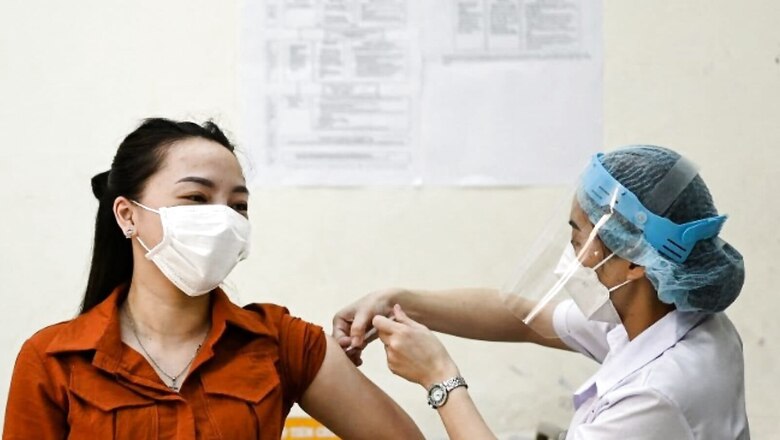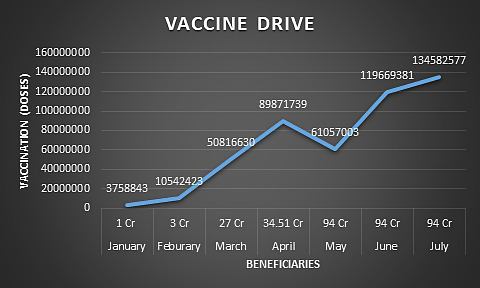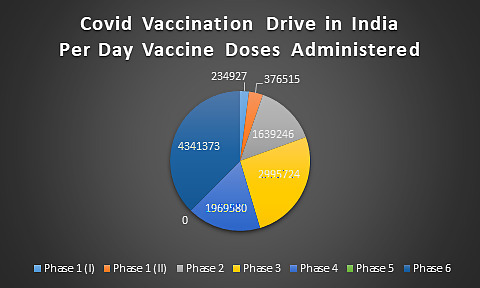
views
India completed 200 days of its Covid-19 vaccination drive on August 3 having administered a total of 48,52,86,570 doses. In these 200 days, on average, India administered 24,26,432 vaccine doses daily. As per the 2011 Census, India has around 94 crore individuals above 18 years of age, while the overall population figure is 136 crore. So far, 10,71,95,973 individuals, i.e, 11.40% of the adult population and 7.87% of the total population in India has been vaccinated.
India is currently using three Covid vaccines – Covishield and Covaxin manufactured in India, and Sputnik V imported from Russia – with Covishield accounting for over 90% of vaccinations in the country. All are two-shot vaccines. While the vaccination drive has an overall average vaccination rate of over 24 lakh doses per day, the pace of vaccination has significantly gone up in the months of June and July, crossing the 40 lakh mark a day.
We take a look at how the vaccination drive has progressed so far, breaking it month by month.
Phase 1 – January 2021: India began its vaccination drive on January 16, 2021 with the approval of the emergency use of Covishield and Covaxin. The first phase of vaccination in January was for around 1 crore healthcare workers (HCWs) directly engaged in the Covid treatment process, as per the Government of India (GOI) estimates. They were the first on the priority list. A total of 37,58,843 vaccines were administered during the 16 days of the drive, vaccinating an average of 2,34,927 HCWs per day.
Phase 1 – February 2021: As per the GOI estimates, around 2 crore frontline workers (FLWs) were added to the 1st phase of the vaccination drive in February, raising the beneficiary count to 3 crore. FLWs are the connecting links between the society, industry and administration and include police persons, journalists, drivers and courier boys for delivering essential services. A total of 1,05,42,423 doses of vaccines were delivered to HCWs and FLWs — with an average 3,76,515 doses administered per day.
Phase 2 – March 2021: India began its mass vaccination drive from March 2021. The targeted beneficiary base in this phase was 27 crore, as per the government estimates, raising the beneficiary count to 30 crore. This included population age in the age group of above 60 years of age and those above 45 years of age with comorbidities. As per Census 2011 projections, India has 13.79 crore people above 60 years of age. That leaves 13.21 crore people with comorbidities in the targeted beneficiary group. Phase 2 of the vaccination drive administered 5,08,16,630 doses, or an average 16,39,246 vaccine doses a day.

Phase 3 – April 2021: The third phase of vaccination was opened up on April 1 for the entire population above 45 years of age, or 34.51 crore people, as per the 2011 Census projection. The drive that month administered 8,98,71,739 vaccine shots, or 29,95,724 doses per day.
April saw the disastrous second Covid wave with 45,882 Covid fatalities and India crossing the 200,000 mark of reported deaths from Covid. India also reported over 66 lakh Covid cases in April as the cumulative total rose to around 1.9 crore. The country witnessed the highest daily total of cases globally, which further went up in May.
Liberalised vaccination policy
The vaccination drive till Phase 3 was conducted by the Central Government. But from May onwards the GOI, as demanded by many state governments, introduced a liberalised vaccination policy to decentralise the drive. With Covid cases and fatalities shooting up, vaccination centres saw more people queuing up to get vaccinated, resulting in a shortage of vaccines, with many states raising complaints about it. They even asked to import Covid vaccines from abroad to meet the shortfall if they were allowed to do so. Many of them, along with many other political leaders, demanded that the vaccine drive be open to all.
The result? The vaccine drive was made a mixed-mode of operation that was open to all adults. The GOI took responsibility to provide free vaccine doses to HCWs, FLWs and the 45+ population base, while state governments and union territories and private hospitals had the responsibility of vaccinating the population base between 18 and 44 years of age.
Phase 4 – May 2021: With the second wave scaling worrisome peaks, the inoculation exercise was opened for all adults of the country, or the population base that is above 18 years of age, i.e., 94 crore individuals, in the fourth phase of the drive in May, the month that saw the peak of the second Covid wave.
From 80,000 cases on April 1, India hit the highest-ever single-day global record of 4.14 lakh new Covid-19 cases on May 6. The active caseload burden went over 37 lakh, combined with a sharp decline in recovery rate from more than 97% to less than 80%. The death rate was consistently high in the range of 3,000-4,000 fatalities on many days. It crossed the highest-ever figure of 6,148 deaths on June 9, while the whole month saw 120,770 Covid fatalities.
Shortage of vaccines
While the target population base from April to May expanded over 2.7 times, the manufacturing capacity available in the country remained the same, around 7.5 crore doses a month. India’s pace of vaccinating its citizens dropped in May because of the lack of availability of vaccines. The month saw just 6,10,57,003 doses administered that comes to an average of 20.35 lakh doses a day, a fall of 32% from April.
Red flags were raised on vaccine shortage. State governments and union territories said they were not able to get vaccine doses from the manufacturers directly as their production pipeline was already choked with the orders from the central government. They only started getting direct vaccine supply from the second fortnight of May. Many of them tried to float global tenders, but international manufacturers like Pfizer and Moderna said they would deal only with the Government of India.
Then there were other problems like the difference in the price of vaccines for the central and the state governments, vaccine hesitancy in small towns and rural India, the problem of the government’s Co-WIN portal being available only in English, and a digital divide between urban, small-town and rural India, and high vaccine wastage rate in some states. When the state governments realised these limitations, they had no other option but to go back to the Centre, urging it to take the vaccine drive under its control again.

Phase 5 – June 2021: The vaccine drive was brought under the control of the Central government again from June 21, a day that witnessed over 86 lakh vaccinations. The next 10 days, from June 21 to June 30 saw an average of 52,55,937 doses being administered daily. That means 44% or 5,25,59,373 Covid vaccine doses of the total shots administered in the month of June were done in just these 10 days. A total of 11,96,69,381 Covid vaccine doses, which, on average, is 39,88,979 doses a day, were administered in June. It was a big jump of 96% from the month of May. June was also the month that saw the pandemic slowing down in the country.
Phase 7 – July 2021: July saw vital parameters like the R-value going up again and significantly in the last 15 days, with an assessment that the third Covid wave may hit India soon, in the month of August. A total of 13,45,82,577 vaccine doses were administered, an average of 43,41,373 jabs a day. It is a 12.5% increase over the pace of vaccination in June. India became the third country in July to cross the 10 crore mark of fully vaccinated citizens, behind China and the US.
The Road Ahead
The decrease of the active caseload burden saw a significant decrease in July. The active caseload burden, in fact, has started increasing again, almost daily in the last week. The R-value must be lower than 1 for Covid cases to decline, but it has already crossed that level. The Institute of Mathematical Sciences, Chennai, on July 27 estimated that India’s R-value crossed the mark of 1. This is an indication that the third Covid wave will hit India soon, in this month, as said by AIIMS director Randeep Guleria and other health experts. At a time like this, vaccination is the only option available as a safeguard with no other treatment available for Covid.
India has revised its vaccination target for August which has so far has seen 1,40,69,926 doses delivered in the first three days. India is expected to see around 15 crore vaccinations this month according to Dr VK Paul from NITI Aayog. It is significantly less than the earlier target of 25 crore set in May. On May 31, Dr NK Arora from the National Technical Advisory Group on Immunisation had said India could ramp up vaccine production and was expected to get around 25 crore vaccine doses in August. It clearly indicates that domestic manufactures have not been able to ramp up their production levels to the desired capacity as expected. Also, so far, India has not been able to finalise any new deal to import other foreign vaccines other than Sputnik V from Russia.
Read all the Latest News, Breaking News and Coronavirus News here.




















Comments
0 comment